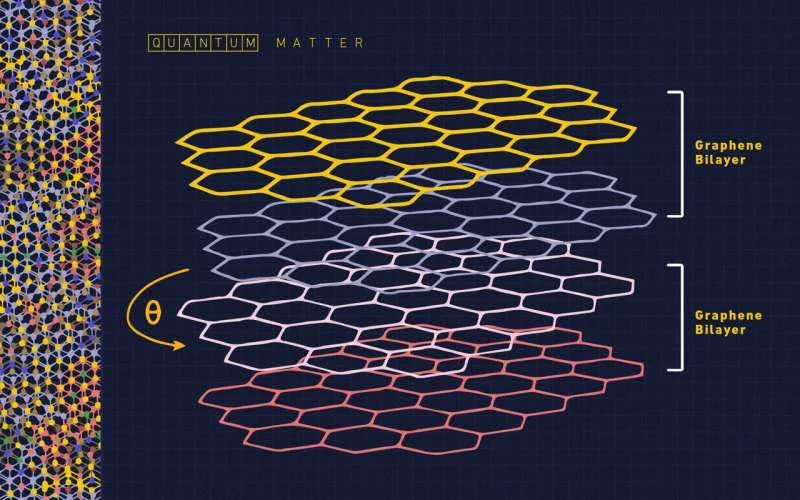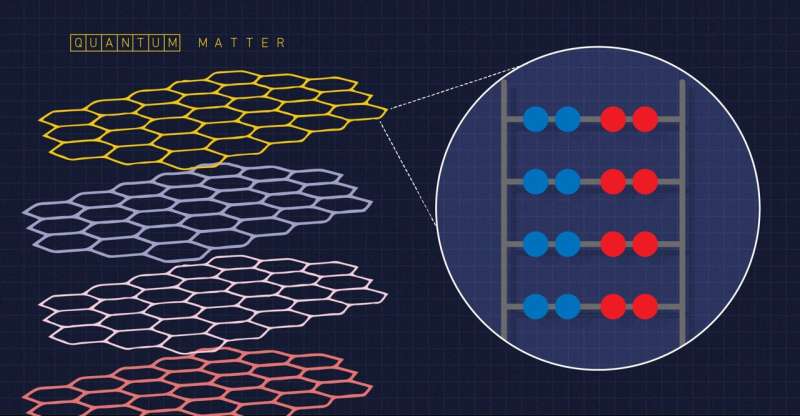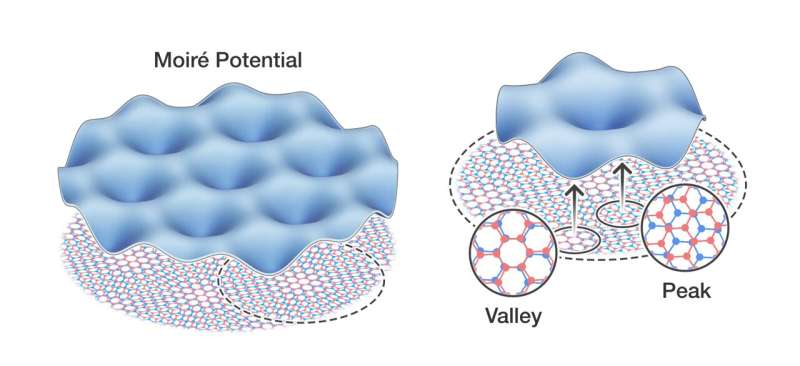Scientists find new quantum ruler to study exotic matter
- October 5, 2023
- 0
The single-atom-thick layer of carbon known as graphene has remarkable properties on its own, but things can get even more interesting when you stack several layers on top
The single-atom-thick layer of carbon known as graphene has remarkable properties on its own, but things can get even more interesting when you stack several layers on top

The single-atom-thick layer of carbon known as graphene has remarkable properties on its own, but things can get even more interesting when you stack several layers on top of each other.
When two or more overlapping sheets of graphene are gently shifted (bent at specific angles relative to each other), they take on a number of exotic identities. Known as Moiré quantum matter, these materials can suddenly generate their own magnetic fields depending on the bending angle, becoming superconductors with zero electrical resistance or, conversely, perfect insulators.
Joseph A. Stroscio and his colleagues at the National Institute of Standards and Technology (NIST), along with a team of international collaborators, have developed a “quantum ruler” to measure and study the peculiar properties of these twisted materials. The work could also lead to a new miniature electrical resistance standard that could calibrate electronic devices directly at the factory, eliminating the need to send them to an off-site standards laboratory.
Co-author Fereshte Gahhari, a physicist at George Mason University in Fairfax, Virginia, took two layers of graphene (known as bilayer graphene) about 20 micrometers in diameter and bent them against two other layers, creating a moiré quantum matter device. Gahhari created the device using nanofabrication at NIST’s Center for Nanoscale Science and Technology.
NIST researchers Marlou Slot and Yulia Maksimenko then cooled this twisted material device to one-hundredths of a degree above absolute zero, reducing the random motions of atoms and electrons and increasing the ability of electrons in the material to interact. They investigated how electron energy levels in graphene layers change when varying the strength of a strong external magnetic field after reaching ultra-low temperatures. Measuring and manipulating electron energy levels is critical for the design and fabrication of semiconductor devices.
The team used the universal scanning tunneling microscope that Stroscio designed and built at NIST to measure energy levels. When the researchers applied voltage to the bilayer of graphene in a magnetic field, the microscope recorded a small current from electrons “tunneling” through the material to the tip of the microscope’s probe.
Electrons move in circular paths in the magnetic field. As a general rule, circular orbits of electrons in solid materials have a special relationship to the applied magnetic field: the area occupied by each circular orbit multiplied by the applied field can only take on a set of fixed discrete values. Quantum nature of electrons.
To maintain this constant multiplication, if the magnetic field is halved, the area enclosed by the orbital electron must double. The energy difference between successive energy levels corresponding to this pattern can be used as marks on a ruler to measure the electronic and magnetic properties of a material. The slightest deviation from this model could mean a new quantum line that could reflect the orbital magnetic properties of the particular quantum moiré material the researchers are studying.

In fact, NIST researchers discovered evidence of a new quantum line when they varied the magnetic field applied to the double layer of moiré graphene. The area bounded by the circular orbit of the electrons multiplied by the applied magnetic field no longer equaled a constant value. Instead, the product of these two numbers shifted by an amount that depended on the magnetization of the double layers.
This deviation translates into a series of different labels for electron energy levels. The resulting data promises to shed new light on how electrons confined to twisted graphene sheets give rise to new magnetic properties.
“By using the new quantum ruler to study how circular orbits change with the magnetic field, we hope to uncover the subtle magnetic properties of these moiré quantum materials,” Strosio said.
In moire quantum materials, electrons have an egg-carton-shaped range of high and low possible energies determined by the materials’ electric field. The electrons are concentrated in the lower energy states, or valleys, of the box. NIST theoretical physicist Paul Haney said that the large spacing between valleys in double layers, larger than the atomic spacing in any single layer of graphene or multiple unbent layers, explains some of the unusual magnetic properties the team discovered.
The researchers, including colleagues from the University of Maryland at College Park and the Joint Quantum Institute, a research partnership between NIST and the University of Maryland, describe their work in the journal Science .

Because the properties of moiré quantum matter can be selected by choosing a specific spin angle and number of atomically thin layers, the new measurements promise to provide a deeper understanding of how scientists can tailor and optimize the magnetic and electronic properties of host quantum materials. Applications in microelectronics and related fields. For example, it is already known that ultrathin superconductors are extremely sensitive detectors of single photons, and quantum moire superconductors are among the thinnest.
The NIST team is also interested in another application: Under the right conditions, moire quantum matter could provide a new, easy-to-use standard for electrical resistance.
The current standard is based on discrete resistance values that a material achieves when a strong magnetic field is applied to electrons in a two-dimensional layer. This phenomenon, known as the quantum Hall effect, is due to the same quantized energy levels of electrons in the circular orbits discussed above. Individual resistance values can be used to calibrate resistance in various electrical devices. However, since a strong magnetic field is required, calibration can only be done in metrology facilities such as NIST.
If researchers can manipulate moiré quantum matter to have net magnetization even in the absence of an external applied magnetic field, then this could potentially be used to create a new portable version of the most accurate resistivity standard known as anomalous quantum, Stroscio said. Hall resistor standard. Calibration of electronic devices can be done in a factory environment, potentially saving millions of dollars.
Source: Port Altele
As an experienced journalist and author, Mary has been reporting on the latest news and trends for over 5 years. With a passion for uncovering the stories behind the headlines, Mary has earned a reputation as a trusted voice in the world of journalism. Her writing style is insightful, engaging and thought-provoking, as she takes a deep dive into the most pressing issues of our time.